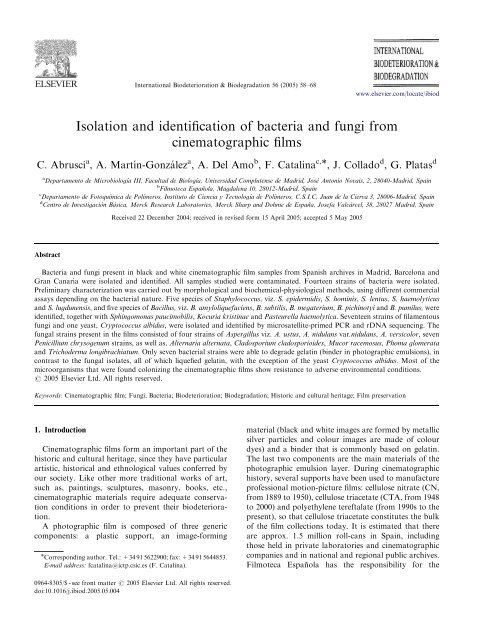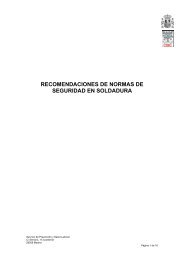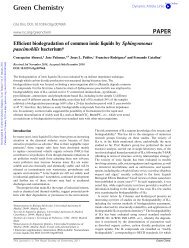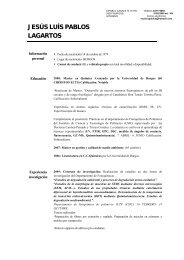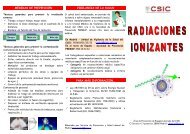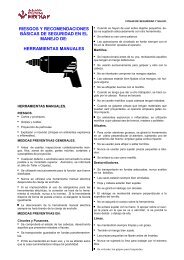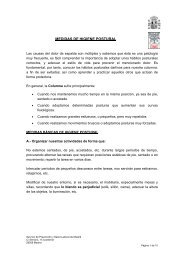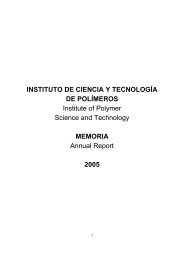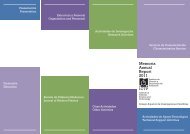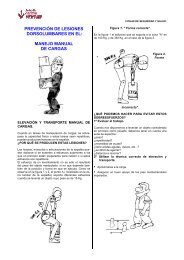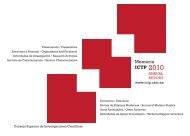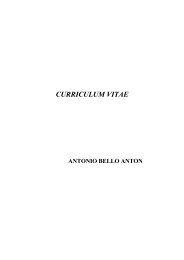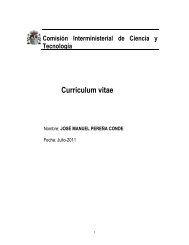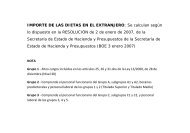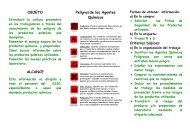Isolation and identification of bacteria and fungi from ... - ictp
Isolation and identification of bacteria and fungi from ... - ictp
Isolation and identification of bacteria and fungi from ... - ictp
- No tags were found...
You also want an ePaper? Increase the reach of your titles
YUMPU automatically turns print PDFs into web optimized ePapers that Google loves.
ARTICLE IN PRESS<br />
International Biodeterioration & Biodegradation 56 (2005) 58–68<br />
www.elsevier.com/locate/ibiod<br />
<strong>Isolation</strong> <strong>and</strong> <strong>identification</strong> <strong>of</strong> <strong>bacteria</strong> <strong>and</strong> <strong>fungi</strong> <strong>from</strong><br />
cinematographic films<br />
C.Abrusci a , A.Martín-Gonza´ lez a , A.Del Amo b , F.Catalina c, , J.Collado d , G.Platas d<br />
a Departamento de Microbiología III, Facultad de Biología, Universidad Complutense de Madrid, José Antonio Novais, 2, 28040-Madrid, Spain<br />
b Filmoteca Española, Magdalena 10, 28012-Madrid, Spain<br />
c Departamento de Fotoquímica de Polímeros, Instituto de Ciencia y Tecnología de Polímeros, C.S.I.C, Juan de la Cierva 3, 28006-Madrid, Spain<br />
d Centro de Investigación Básica, Merck Research Laboratories, Merck Sharp <strong>and</strong> Dohme de España, Josefa Valcárcel, 38, 28027 Madrid, Spain<br />
Received 22 December 2004; received in revised form 15 April 2005; accepted 5 May 2005<br />
Abstract<br />
Bacteria <strong>and</strong> <strong>fungi</strong> present in black <strong>and</strong> white cinematographic film samples <strong>from</strong> Spanish archives in Madrid, Barcelona <strong>and</strong><br />
Gran Canaria were isolated <strong>and</strong> identified.All samples studied were contaminated.Fourteen strains <strong>of</strong> <strong>bacteria</strong> were isolated.<br />
Preliminary characterization was carried out by morphological <strong>and</strong> biochemical-physiological methods, using different commercial<br />
assays depending on the <strong>bacteria</strong>l nature.Five species <strong>of</strong> Staphylococcus, viz. S. epidermidis, S. hominis, S. lentus, S. haemolyticus<br />
<strong>and</strong> S. lugdunensis, <strong>and</strong> five species <strong>of</strong> Bacillus, viz. B. amyloliquefaciens, B. subtilis, B. megaterium, B. pichinotyi <strong>and</strong> B. pumilus, were<br />
identified, together with Sphingomonas paucimobilis, Kocuria kristinae <strong>and</strong> Pasteurella haemolytica.Seventeen strains <strong>of</strong> filamentous<br />
<strong>fungi</strong> <strong>and</strong> one yeast, Cryptococcus albidus, were isolated <strong>and</strong> identified by microsatellite-primed PCR <strong>and</strong> rDNA sequencing.The<br />
fungal strains present in the films consisted <strong>of</strong> four strains <strong>of</strong> Aspergillus viz. A. ustus, A. nidulans var.nidulans, A. versicolor, seven<br />
Penicillium chrysogenum strains, as well as, Alternaria alternata, Cladosporium cladosporioides, Mucor racemosus, Phoma glomerata<br />
<strong>and</strong> Trichoderma longibrachiatum.Only seven <strong>bacteria</strong>l strains were able to degrade gelatin (binder in photographic emulsions), in<br />
contrast to the fungal isolates, all <strong>of</strong> which liquefied gelatin, with the exception <strong>of</strong> the yeast Cryptococcus albidus.Most <strong>of</strong> the<br />
microorganisms that were found colonizing the cinematographic films show resistance to adverse environmental conditions.<br />
r 2005 Elsevier Ltd.All rights reserved.<br />
Keywords: Cinematographic film; Fungi; Bacteria; Biodeterioration; Biodegradation; Historic <strong>and</strong> cultural heritage; Film preservation<br />
1. Introduction<br />
Cinematographic films form an important part <strong>of</strong> the<br />
historic <strong>and</strong> cultural heritage, since they have particular<br />
artistic, historical <strong>and</strong> ethnological values conferred by<br />
our society.Like other more traditional works <strong>of</strong> art,<br />
such as, paintings, sculptures, masonry, books, etc.,<br />
cinematographic materials require adequate conservation<br />
conditions in order to prevent their biodeterioration.<br />
A photographic film is composed <strong>of</strong> three generic<br />
components: a plastic support, an image-forming<br />
Corresponding author.Tel.: +34 91 5622900; fax: +34 91 5644853.<br />
E-mail address: fcatalina@<strong>ictp</strong>.csic.es (F. Catalina).<br />
material (black <strong>and</strong> white images are formed by metallic<br />
silver particles <strong>and</strong> colour images are made <strong>of</strong> colour<br />
dyes) <strong>and</strong> a binder that is commonly based on gelatin.<br />
The last two components are the main materials <strong>of</strong> the<br />
photographic emulsion layer.During cinematographic<br />
history, several supports have been used to manufacture<br />
pr<strong>of</strong>essional motion-picture films: cellulose nitrate (CN,<br />
<strong>from</strong> 1889 to 1950), cellulose triacetate (CTA, <strong>from</strong> 1948<br />
to 2000) <strong>and</strong> polyethylene tereftalate (<strong>from</strong> 1990s to the<br />
present), so that cellulose triacetate constitutes the bulk<br />
<strong>of</strong> the film collections today.It is estimated that there<br />
are approx.1.5 million roll-cans in Spain, including<br />
those held in private laboratories <strong>and</strong> cinematographic<br />
companies <strong>and</strong> in national <strong>and</strong> regional public archives.<br />
Filmoteca Espan˜ ola has the responsibility for the<br />
0964-8305/$ - see front matter r 2005 Elsevier Ltd.All rights reserved.<br />
doi:10.1016/j.ibiod.2005.05.004
ARTICLE IN PRESS<br />
C. Abrusci et al. / International Biodeterioration & Biodegradation 56 (2005) 58–68 59<br />
conservation <strong>and</strong> preservation <strong>of</strong> 430,000 roll-cans that<br />
constitute an important <strong>and</strong> irreplaceable historical <strong>and</strong><br />
cultural heritage.<br />
The image stability depends on both intrinsic factors,<br />
e.g. the nature <strong>of</strong> the polymer base, <strong>and</strong> extrinsic factors,<br />
e.g. environmental conditions. Archivists have encountered<br />
the problem <strong>of</strong> film deterioration caused by<br />
inappropriate storage conditions <strong>of</strong> temperature <strong>and</strong><br />
moisture.Many efforts have focused on the decrease <strong>of</strong><br />
the physical damage caused by the ‘‘vinegar syndrome’’<br />
in cellulose acetate-based films (Catalina <strong>and</strong> Del Amo,<br />
1999) <strong>and</strong> the fading <strong>of</strong> colour dyes.In contrast, there is<br />
a lack <strong>of</strong> knowledge about the contamination by<br />
<strong>bacteria</strong> <strong>and</strong> <strong>fungi</strong> in cinematographic archives <strong>and</strong> its<br />
influence on film stability.Studies on microbial contamination<br />
<strong>of</strong> cinematographic films stored in archives<br />
are scant <strong>and</strong> have been reviewed by Abrusci et al.<br />
(2004a).The main work has been done by Opela (1992)<br />
<strong>and</strong> involved the analysis <strong>of</strong> cellular concentration <strong>and</strong><br />
the <strong>identification</strong> <strong>of</strong> the principal fungal contaminants in<br />
the air, on floors, in cans <strong>and</strong> on cinematographic films<br />
in two different archives <strong>of</strong> the Slovak Republic.As in<br />
other studies <strong>of</strong> indoor habitats, the results indicated<br />
that certain environmental conditions, such as, air flow,<br />
temperature, movement <strong>of</strong> personnel, etc., had a crucial<br />
effect on microbial concentrations in the diverse places<br />
analyzed.The fungal biodiversity was higher in the air<br />
than in the surface <strong>of</strong> the films, biodiversity being<br />
limited in archives, with filamentous species in the<br />
genera Penicillium <strong>and</strong> Aspergillus being the predominant<br />
micromycetes (Opela, 1992). Aspergillus <strong>and</strong><br />
Penicillium have been reported as the most frequently<br />
found micromycetes in indoor air <strong>and</strong> buildings <strong>from</strong><br />
cold <strong>and</strong> temperate climate regions (Frisvad <strong>and</strong> Gravesen,<br />
1994; Hyva¨ rinen et al., 2002).These <strong>fungi</strong> are<br />
considered to be primary colonizers, since they are<br />
capable <strong>of</strong> growing at a w o0:8, although many species<br />
have the optimum for growth at a w values close to 1<br />
(Nielsen, 2003).Other genera <strong>of</strong> <strong>fungi</strong> (Alternaria,<br />
Cladosporium, Phoma, etc.) are secondary colonizers,<br />
because they require a w values at least between 0.8 <strong>and</strong><br />
0.9 (Nielsen, 2003).The presence <strong>of</strong> spores <strong>and</strong>/or<br />
vegetative cells <strong>of</strong> microorganisms on the surface <strong>of</strong><br />
materials indicate the possibility <strong>of</strong> future biodegradation<br />
or biodeterioration.However, colonization or<br />
microbial growth on a material almost always results<br />
in biodeterioration <strong>of</strong> the material.There are different<br />
ways in which microorganisms can compromise the<br />
structure <strong>and</strong> function <strong>of</strong> polymeric materials (Flemming,<br />
1998).For instance, they can produce pigmentation<br />
or degrade <strong>of</strong> one or more compounds.In other<br />
cases, they can hydrate, <strong>and</strong> as well as causing fouling,<br />
they may penetrate into the polymeric material.These<br />
mechanisms <strong>of</strong> biodeterioration occur when microorganisms<br />
are metabolically active <strong>and</strong> growing, but<br />
although the environment contains an extremely rich<br />
variety <strong>of</strong> microorganisms, usually only a few <strong>of</strong> the<br />
microorganisms isolated <strong>from</strong> a substrate are responsible<br />
for damaging it.<br />
In cinematographic films, the organic components<br />
mentioned previously can be considered as potential<br />
carbon sources for growth <strong>of</strong> microorganisms, if<br />
environmental conditions are adequate.Gelatin, the<br />
binder <strong>of</strong> the photographic emulsion, is the most<br />
biodegradable <strong>of</strong> the substrates.It is composed <strong>of</strong> high<br />
molecular weight polypeptides derived <strong>from</strong> collagen,<br />
<strong>and</strong> the most widely used photographic gelatin is type-B,<br />
obtained by basic pre-treatment <strong>of</strong> bones (Abrusci et al.,<br />
2004b).Many prokaryotic <strong>and</strong> eukaryotic microorganisms<br />
exhibit proteolytic capacity, so they are able to<br />
degrade gelatin. Stickley (1986) studied by viscometry<br />
the biodegradation <strong>of</strong> 5% aqueous gelatin solutions at<br />
37 1C using single strains <strong>of</strong> Bacillus <strong>and</strong> Pseudomonas.<br />
In both cases, reduced viscosity was detected after 24 h.<br />
In a more detailed study, Abrusci et al.(2004c)<br />
viscosimetrically analysed the biodegradation <strong>of</strong> type-B<br />
gelatin (Bloom 225) by <strong>bacteria</strong> isolated <strong>from</strong> cinematographic<br />
films, <strong>and</strong> noted that temperature is a very<br />
important factor affecting rate <strong>of</strong> biodegradation<br />
(Abrusci et al., 2004c).<br />
As for film base materials, a large number <strong>of</strong> studies<br />
have been carried out on biodegradation <strong>of</strong> cellulose<br />
acetates (CA) by both <strong>bacteria</strong> <strong>and</strong> <strong>fungi</strong>.The degree <strong>of</strong><br />
hydroxyl substitution (acetylation) has been found to be<br />
a factor with a strong influence on biodegradation, those<br />
CA with a higher degree <strong>of</strong> acetylation being more<br />
resistant to microbial attack (Buchanan et al., 1993;<br />
Nelson et al., 1993; Sakai et al., 1996).According to<br />
Sakai et al.(1996), CA biodegradation is mediated by<br />
the cooperative action <strong>of</strong> esterase(s), lipase(s) <strong>and</strong><br />
cellulase(s).These studies were carried out adding pure<br />
cultures <strong>of</strong> identified species (Samios et al., 1997; Nelson<br />
et al., 1993) or using mixed populations such as those<br />
included in compost (Gu et al., 1993b).The cellulose<br />
triacetate used in the photographic industry has a degree<br />
<strong>of</strong> substitution <strong>of</strong> approx.2.7.Hence, its resistance to<br />
biodegradation should be much higher than the other<br />
components <strong>of</strong> the film.In fact, it has been reported that<br />
microorganisms attack the organic part <strong>of</strong> the film<br />
emulsion especially at R.H. 460% ða w 40:6Þ (Gordon,<br />
1983).In tropical climates fungal growth is a special<br />
problem, but it is also possible to detect these troublesome<br />
growths during the summer in temperate zones<br />
with high relative humidity.<br />
Owing to the risk <strong>of</strong> biodeterioration <strong>of</strong> cinematographic<br />
film in the Spanish archives, we isolated <strong>and</strong><br />
identified <strong>bacteria</strong> <strong>and</strong> <strong>fungi</strong> <strong>from</strong> selected samples <strong>of</strong><br />
cinematographic films collected in different archives.<br />
The <strong>identification</strong> studies in organisms <strong>from</strong> black <strong>and</strong><br />
white cinematographic films are presented here, along<br />
with an analysis <strong>of</strong> the ability <strong>of</strong> these isolates to<br />
hydrolyse the gelatinous component <strong>of</strong> films.
60<br />
ARTICLE IN PRESS<br />
C. Abrusci et al. / International Biodeterioration & Biodegradation 56 (2005) 58–68<br />
2. Materials <strong>and</strong> methods<br />
2.1. Cinematographic film samples<br />
Film samples <strong>from</strong> collections at Barcelona, Madrid<br />
<strong>and</strong> Gran Canaria archives were supplied by Filmoteca<br />
Espan˜ ola.The sampling <strong>and</strong> transport <strong>of</strong> the samples<br />
were carried out under aseptic conditions.The films<br />
supplied appeared to be in good condition.<br />
2.2. <strong>Isolation</strong> <strong>of</strong> microorganisms <strong>from</strong> cinematographic<br />
films<br />
The isolation procedure for all samples was performed<br />
in a laminar-flow chamber <strong>and</strong> manual operations<br />
were carried out using sterile disposable gloves.<br />
From each cinematographic sample, two or three pieces<br />
were placed on trypticase-soya-agar (TSA), for heterotrophic<br />
<strong>bacteria</strong>, <strong>and</strong> Sabouraud-glucose-agar (SAB)<br />
supplemented with choramphenicol for <strong>fungi</strong>.Petri<br />
dishes were incubated at 30 1C for 1–2 weeks.Cultures<br />
were observed daily under a stereoscopic microscope to<br />
check the presence <strong>of</strong> <strong>bacteria</strong>l colonies <strong>and</strong>/or fungal<br />
mycelium (Fig.1).<br />
2.3. Characterization <strong>of</strong> <strong>bacteria</strong><br />
Each <strong>bacteria</strong>l strain isolated <strong>from</strong> the film samples<br />
was cultured on TSA either at 30 or 37 1C for 48 h.<br />
Replicates were made <strong>and</strong> preserved at 4 1C or 80 1C<br />
using TSB liquid medium supplemented with glycerol.<br />
Gram- <strong>and</strong> simple staining were performed using<br />
exponential TSA cultures, <strong>and</strong> oxidase <strong>and</strong> catalase tests<br />
made.Acid production <strong>from</strong> glucose <strong>and</strong> sucrose on OF<br />
basal medium, growth on Simmons citrate agar, <strong>and</strong><br />
starch <strong>and</strong> gelatin hydrolysis, were tested.In all Grampositive<br />
(<strong>and</strong> some Gram-negative strains), the ability to<br />
form spores was tested by examining 24-, 48- <strong>and</strong> 72-h,<br />
<strong>and</strong> 1-week cultures on TSA, as well as the Schaeffer-<br />
Fulton specific stain (Forbes et al., 2002).Morphological<br />
characters were examined under differential interference<br />
contrast (Nomarski) <strong>and</strong> phase contrast using a<br />
Zeiss Laboval 4 optical microscope.<br />
Fig.1.One-week Petri dish cultures at 30 1C showing on left<br />
micr<strong>of</strong>ungi P. chrysogenum (upper) <strong>and</strong> A. alternata (lower), <strong>and</strong> on<br />
right B. subtilis developing <strong>from</strong> fragments <strong>of</strong> film.<br />
After the preliminary morphological <strong>and</strong> physiological<br />
characterization as used by Oppong et al.(2000),<br />
<strong>bacteria</strong>l strains were identified employing commercial<br />
<strong>identification</strong> kits.Depending on the <strong>bacteria</strong>l nature,<br />
different commercial assays were employed such us API<br />
20 NE, API 20E, API 50 CHB <strong>and</strong> API STAPH.The<br />
preparation <strong>and</strong> inoculation procedures followed the<br />
recommendations <strong>of</strong> the manufacturer (BioMerieux<br />
Espan˜ a S.A.), with the strains being incubated at 30 1C<br />
for 24 h.The numeric pr<strong>of</strong>iles obtained were compared<br />
with a <strong>bacteria</strong>l database using the commercial s<strong>of</strong>tware<br />
APILAB <strong>from</strong> BioMerieux.Simultaneously, additional<br />
diagnostic tests were made with some <strong>bacteria</strong>l strains,<br />
such as growth on McConkey or mannitol salt agar <strong>and</strong><br />
coagulase <strong>and</strong> lysostaphin tests.<br />
2.4. <strong>Isolation</strong> <strong>and</strong> characterization <strong>of</strong> <strong>fungi</strong><br />
For isolation <strong>of</strong> micromycetes, film samples were<br />
incubated on potato-dextrose-agar (PDA) at 28 1C or<br />
30 1C for 1–2 weeks.Replicates were preserved at 4 1Cor<br />
80 1C in PD broth medium supplemented with 10%<br />
glycerol.<br />
The following media were used for characterization:<br />
(a) malt extract agar (MEA) composed <strong>of</strong> malt<br />
extract (Difco) 20 g, peptone 1 g, glucose 20 g, agar<br />
20 g, distilled water 1 L; (b) Czapek yeast extract agar<br />
(CYA) composed <strong>of</strong> K 2 HPO 4 1 g, Czapek concentrate<br />
10 ml, yeast extract (Difco) 5 g, Sucrose 30 or 200 g, agar<br />
15 g, distilled water 1 L; (c) 25% glycerol nitrate agar<br />
(G25N) composed <strong>of</strong> K 2 HPO 4 0.75 g, Czapek concentrate<br />
7.5 ml, yeast extract 3.7 g, glycerol, analytical grade<br />
250 g, agar 12 g, distilled water 750 ml; (d) potato-carrotagar<br />
(PCA) composed <strong>of</strong> shredded potato 20 g, shredded<br />
carrot 20 g, agar 20 g, distilled water 1 L; <strong>and</strong> (e) PDA<br />
(Difco).Czapek concentrate contained: NaNO 3 30 g,<br />
KCl 5 g, MgSO 4 .7H 2 O 5 g, FeSO 4 .7H 2 O 0.1 g ZnSO 4 .7<br />
H 2 O 0.1 g, CuSO 4 .5H 2 O 0.05 g, distilled water 100 ml.<br />
Seven-day cultures on MEA, CYA (with either 3% or<br />
20% sucrose), <strong>and</strong> G25N were used for <strong>identification</strong> <strong>of</strong><br />
Aspergillus <strong>and</strong> Penicillium species, based on the<br />
procedures described by Pitt (2000) <strong>and</strong> Klich (2001).<br />
The other strains were cultured on PDA <strong>and</strong> PCA for 21<br />
days at 22 1C <strong>and</strong> 80% R.H. <strong>and</strong> then subjected to cycles<br />
<strong>of</strong> NUV wavelength light exposure-darkness (12 h each)<br />
at room temperature for at least 14 days to stimulate<br />
sporulation.Morphological analysis <strong>of</strong> the isolates was<br />
carried out with a Leitz Diaplan microscope, equipped<br />
with differential interference contrast optics.The fungal<br />
isolates were identified to species (Aspergillus <strong>and</strong><br />
Penicillium) or generic level.<br />
The yeast isolate was identified on the basis <strong>of</strong><br />
metabolic/physiological features using the API 20C-<br />
AUX kit (BioMerieux Espan˜ a, S.A.), <strong>and</strong> simple crystal<br />
violet staining was used for observing cell size <strong>and</strong><br />
shape.
ARTICLE IN PRESS<br />
C. Abrusci et al. / International Biodeterioration & Biodegradation 56 (2005) 58–68 61<br />
2.5. PCR reactions, microsatellite primed PCR <strong>and</strong><br />
rDNA amplifications <strong>and</strong> sequence in <strong>fungi</strong><br />
DNA extraction was performed by the methodology<br />
described by Pela´ ez et al.(1996).Mycelium was removed<br />
<strong>from</strong> the agar plate with a razor blade, fragmented <strong>and</strong><br />
suspended in 1 ml lysis buffer (50 mM EDTA, pH 8.5,<br />
0.2% SDS) <strong>and</strong> heat-shock treated at 75 1C for 30 min.<br />
After centrifugation in a Bi<strong>of</strong>uge 13 (Heraeus) at<br />
15,000 rpm <strong>and</strong> supernatant was adjusted to a final<br />
concentration <strong>of</strong> 0.3 M potassium acetate <strong>and</strong> chilled for<br />
1 h in ice.After a second centrifugation step, the<br />
supernatant was mixed with 2 volumes absolute ethanol<br />
to precipitate the DNA, which was dissolved in TE<br />
buffer.The DNA concentration obtained using this<br />
procedure ranged <strong>from</strong> 0.01 to 0.1 mgml<br />
1 .<br />
The amplification <strong>of</strong> both internal transcribed spacers<br />
(ITS1 <strong>and</strong> ITS2) <strong>and</strong> the 5.8S gene <strong>of</strong> these isolates<br />
was performed using primers 18S-3 (5 0 TTACGTCCC<br />
TGCCCTTTGTACA3 0 ) <strong>and</strong> NL1R, inverse to NL1<br />
(O’Donnell, 1993) (5 0 CTTTTCCTCCGCTTATTGATA<br />
TCG3 0 ), following st<strong>and</strong>ard procedures (40 cycles <strong>of</strong> 30 s<br />
at 93 1C, 30 s at 531C <strong>and</strong> 2 min at 72 1C) with Taq DNA<br />
polymerase (Q-bioGene) following the procedures recommended<br />
by the manufacturer.Amplification products<br />
(0.1 mgml<br />
1 ) were sequenced using the Bigdye<br />
Terminators version 1.1 (Applied Biosystems, Norwalk<br />
CT, USA) following the procedures recommended by<br />
the manufacturer.For all the amplification products,<br />
each str<strong>and</strong> was sequenced with the same primers used<br />
for the initial amplification.Separation <strong>of</strong> the reaction<br />
products by electrophoresis was performed in an ABI<br />
PRISM 3700 DNA Analyzer (Applied Biosystems).<br />
Partial sequences were assembled manually, <strong>and</strong> a<br />
consensus sequence was generated.Comparison <strong>of</strong> the<br />
DNA sequences was performed with in-house DNA<br />
databases <strong>and</strong> GenBank using the FASTA application.<br />
Microsatellite primed PCR was performed as described<br />
by Bills et al.(1999) using primer (GTG) 5<br />
<strong>and</strong> following st<strong>and</strong>ard procedures (40 cycles <strong>of</strong> 30 s<br />
at 93 1C, 30 s at 53 1C <strong>and</strong> 2 min at 72 1C) with Taq<br />
DNA polymerase (Q-bioGene) following the procedures<br />
recommended by the manufacturer.The DNA fragments<br />
were separated on a ready-to-use 1.2% agarose<br />
E-gel (Invitrogen), with a 100-base pair ladder for<br />
comparison.<br />
2.6. Gelatin hydrolysis test<br />
With the <strong>bacteria</strong>, two gelatin assays were performed,<br />
a Petri dish <strong>and</strong> a tube tests.The fungal strains were<br />
tested using the latter assay.In the Petri dish test, the<br />
isolate was streaked out on TSA medium supplemented<br />
with gelatin (5 g L 1 ).After incubation for 24–48 h at<br />
37 1C, 5 ml Frazier’s reagent was poured over each<br />
culture plate, <strong>and</strong> the presence <strong>of</strong> a transparent halo<br />
around the microorganism taken as an indication <strong>of</strong> the<br />
positive hydrolysis.The tube test was only applied as<br />
confirmation <strong>of</strong> positive Petri dish test results.In this<br />
second procedure, each strain was used to inoculate by<br />
needle puncture gelatin medium in a test-tube.The<br />
medium <strong>of</strong> a solution <strong>of</strong> 120 g gelatin, 5 g gelatinpeptone<br />
<strong>and</strong> 3 g pure beef extract in 1 L distilled water<br />
that remains fluid at temperatures over 35 1C.The<br />
inoculated tubes were incubated under test for 14 days<br />
at the appropriate temperature for the microorganism.<br />
The tubes were then acclimated at 4 1C <strong>and</strong> gelatin<br />
hydrolysis evidenced by medium drop-down (liquefaction)<br />
when the test-tube was inverted.<br />
2.7. Scanning electron microscopy<br />
For the characterization <strong>of</strong> strains by environmental<br />
scanning electron microscopy (ESEM), a PHILIPS<br />
model XL30 with EDAX X-ray analyzer was used.<br />
Samples were examined employing an environmental<br />
control in the ‘‘wet’’ mode <strong>of</strong> microscope operation<br />
(Go´ mez-Varga, 2004), under which conditions conventional<br />
EM preparation techniques are unnecessary.A<br />
water-cooled Peltier stage was employed to keep the<br />
sample at approximately 2 1C, within a chamber<br />
environment <strong>of</strong> water vapour at a pressure <strong>of</strong> 5 torr<br />
(pressure interval <strong>of</strong> this mode 4–10 torr).For examination<br />
<strong>of</strong> some samples under dry conditions, the samples<br />
were coated with approx.3 nm <strong>of</strong> gold/palladium using<br />
a Polaron SC 7640 sputter coater.<br />
3. Results <strong>and</strong> discussion<br />
3.1. Characterization <strong>and</strong> <strong>identification</strong> <strong>of</strong> the <strong>bacteria</strong>l<br />
isolates<br />
A total <strong>of</strong> 14 <strong>bacteria</strong>l strains were isolated <strong>from</strong> films<br />
stored in the three archives, most being Gram-positive<br />
(Table 1).The rod-like <strong>bacteria</strong> isolated exhibited<br />
motility <strong>and</strong> were oxidase- <strong>and</strong> catalase-positive; they<br />
all produced exopolymers.In their <strong>identification</strong>, the<br />
percentage <strong>of</strong> similarity showed values <strong>of</strong> 97.3–99.9%<br />
for all, except for Staphylococcus haemolyticus (90.1%),<br />
Bacillus amyloliquefaciens (88.1), B. subtilis <strong>and</strong> Pasteurella<br />
haemolytica (86.5%). The Gram-positive rods were<br />
identified as four different species <strong>of</strong> Bacillus.Strain M2,<br />
isolated <strong>from</strong> the Madrid archive, corresponds to B.<br />
pichinotyi (AF 519460), which was first isolated <strong>from</strong><br />
tropical rice soils (Sneath, 1986).This strain has at least<br />
two features that differ <strong>from</strong> the other Bacillus spp: the<br />
Gram stain was always positive <strong>and</strong> endospore formation<br />
was not observed.Two strains <strong>of</strong> B. megaterium<br />
were characterized; one <strong>from</strong> Gran Canaria <strong>and</strong> the<br />
other <strong>from</strong> Barcelona.Both isolates produced abundant<br />
exopolymers <strong>and</strong> poly b-hydroxybutyrate granules.
62<br />
ARTICLE IN PRESS<br />
C. Abrusci et al. / International Biodeterioration & Biodegradation 56 (2005) 58–68<br />
Table 1<br />
Archives, samples, type <strong>of</strong> base, <strong>identification</strong> <strong>and</strong> strain codes <strong>of</strong> the isolated microorganisms form cinematographic films<br />
Archive Sample Base Identification Strain code<br />
Barcelona B1 CTA Alternaria alternata HB1<br />
B2 CTA Staphylococcus epidermidis B2<br />
Aspergillus ustus<br />
HB2<br />
B3 CTA Bacillus amyloliquefaciens B3BA<br />
Bacillus subtilis<br />
B3BS<br />
Cladosporium cladosporioides<br />
HB3A<br />
B4 CTA Sphingomonas paucimobilis B4A<br />
Staphylococcus hominis<br />
B4C<br />
Penicillium chrysogenum<br />
HB41B<br />
Alternaria alternata<br />
HB41N<br />
B5 CN Staphylococcus lentus B5<br />
B6 CTA Penicillium chrysogenum HB6<br />
Cryptococcus albidus<br />
LB6<br />
B7 CN Bacillus megaterium B7<br />
Penicillium chrysogenum<br />
HB7<br />
Gran Canaria GC1 CTA Pasteurella haemolytica GC1A<br />
Staphylococcus lugdunensis<br />
GC1B<br />
Penicillium chrysogenum<br />
HGC1<br />
GC2 CTA Trichoderma longibrachiatum HGC2<br />
Bacillus megaterium<br />
GC2<br />
Aspergillus ustus<br />
HGC2B<br />
GC3 CTA Aspergillus versicolor HGC3<br />
Penicillium chrysogenum<br />
HGC3B<br />
Phoma glomerata<br />
HGC3N<br />
LV a CTA Penicillium chrysogenum HLV1<br />
Madrid M2 CTA Bacillus pichinotyi M2<br />
M3 CTA Staphylococcus haemolyticus M3<br />
Aspergillus nidulans var. nidulans<br />
HM3<br />
M4 CTA Kocuria kristinae M4<br />
Mucor racemosus<br />
HM4<br />
M5 CTA Bacillus pumilus M5<br />
MI CTA Penicillium chrysogenum HMI<br />
CTA: Cellulose triacetate base; CN: cellulose nitrate base.<br />
a LV sample was a fragment <strong>of</strong> a roll-can.<br />
Also, there were six different strains <strong>of</strong> Gram-positive<br />
cocci with cells in chains (B2 <strong>and</strong> B4C), tetrads<br />
(M4) or individual cells (B5, GC1B <strong>and</strong> M3).None<br />
showed motility <strong>and</strong> all were catalase-positive.Only two<br />
Gram-negative rods were isolated (Table 1).They were<br />
oxidase <strong>and</strong> catalase positive, <strong>and</strong> were identified<br />
as P. haemolytica <strong>and</strong> Sphingomonas paucimobilis.<br />
These cocci were identified as Staphylococcus, with the<br />
exception <strong>of</strong> the pigmented strain M4 that corresponds<br />
to yellow pigment producer Kocuria kristinae.<br />
The main habitats <strong>and</strong> morphological/physiological<br />
characteristics <strong>of</strong> the <strong>bacteria</strong>l isolates are <strong>of</strong> relevance in<br />
explaining the potential causes <strong>of</strong> contamination <strong>of</strong> the<br />
films.Members <strong>of</strong> the genus Staphylococcus are widespread<br />
in nature.Owing to their ubiquity <strong>and</strong> adaptability,<br />
they are major inhabitants <strong>of</strong> the skin, skin<br />
gl<strong>and</strong>s <strong>and</strong> mucous membranes <strong>of</strong> humans, other<br />
mammals <strong>and</strong> birds (Kloos et al., 1992).They are<br />
especially resistant to desiccation.At least one <strong>of</strong> the<br />
cocci, S. epidermidis, found in the cinematographic films<br />
produced slime (Me´ ndez-Vilas et al., 2004; Go¨ tz <strong>and</strong><br />
Peters, 2000). S. epidermidis <strong>and</strong> S. hominis are two <strong>of</strong><br />
the most prevalent <strong>and</strong> persistent <strong>bacteria</strong> on human<br />
skin (Schleifer <strong>and</strong> Kloos, 1975; Kloos <strong>and</strong> Schleifer,<br />
1975), S. haemolyticus is usually found in smaller<br />
populations <strong>and</strong> the main habitat <strong>of</strong> S. lugdunensis is<br />
the human nasal cavity where S. haemolyticus can be<br />
also found (Kloos et al., 1992).Most environments<br />
contain transient, small populations <strong>of</strong> staphylococci,<br />
many <strong>of</strong> them probably disseminated by humans or<br />
animals.Mammalian skin is also considered the primary<br />
habitat <strong>of</strong> K. kristinae <strong>and</strong> related micrococci (Cordero<br />
<strong>and</strong> Zumalacarregui, 2000).<br />
The more interesting <strong>of</strong> the two Gram-negative<br />
rods isolated is S. paucimobilis, it is widespread in<br />
nature owing to its physiological <strong>and</strong> metabolic versatility<br />
(Azeredo <strong>and</strong> Oliveira, 2000), most strains produce<br />
an extracellular polysaccharide involved in bi<strong>of</strong>ilm
ARTICLE IN PRESS<br />
C. Abrusci et al. / International Biodeterioration & Biodegradation 56 (2005) 58–68 63<br />
formation (Jin et al., 2003), which has been associated<br />
with biodeterioration processes (Azeredo <strong>and</strong> Oliveira,<br />
2000). Bacillus spp.<strong>of</strong> course are ubiquitous, owing to<br />
their wide range <strong>of</strong> physiological characteristics <strong>and</strong><br />
ability to degrade a wide range <strong>of</strong> substrates (Claus <strong>and</strong><br />
Berkeley, 1986), <strong>and</strong> the majority <strong>of</strong> them produce<br />
endospores that are very resistant to environmental<br />
extremes, antibiotics, disinfectants <strong>and</strong> other chemicals<br />
<strong>and</strong>, are easily disseminated.<br />
In the photographic film manufacturing process,<br />
contamination by gelatin-degrading <strong>bacteria</strong> <strong>of</strong> the<br />
genera Bacillus <strong>and</strong> Pseudomonas has been reported<br />
(Stickley, 1986).More recently, it has been demonstrated<br />
that many <strong>bacteria</strong> can colonize gelatin during<br />
its production process.In addition to Bacillus, which are<br />
predominant, non-sporulating <strong>bacteria</strong>l strains identified<br />
as diverse species in the genera Salmonella,<br />
Kluyvera, Burkholderia, Pseudomonas, Yersinia, Brevundimonas,<br />
Enterococcus, Staphylococcus <strong>and</strong> Streptococcus<br />
have been found (De Clerck <strong>and</strong> De Vos, 2002), <strong>and</strong><br />
have the ability to liquefy gelatin. De Clerck et al.(2004)<br />
reported that in semi-final gelatin extracts almost all<br />
<strong>bacteria</strong>l contaminants were Bacillus or other related<br />
endospore formers (Brevibacillus, Geobacillus <strong>and</strong> Anoxybacillus),<br />
although Enterobacter sakazakii <strong>and</strong> Staphylococcus;<br />
S. epidermidis, S.lugdunensis <strong>and</strong> S.hominis<br />
were also identified.These authors concluded that al<br />
least some spores or vegetative cells were able to resist<br />
the final UHT treatment used to prevent the potential<br />
microbial contamination during gelatin manufacture.<br />
Finally, the other important aspect is the presence <strong>of</strong><br />
<strong>bacteria</strong> in indoor environments, including archives.It is<br />
known that vegetative cells or spores <strong>of</strong> endosporeforming<br />
<strong>bacteria</strong> are common contaminants in indoor<br />
environments, where other genera <strong>of</strong> <strong>bacteria</strong>, such as<br />
Kocuria, Micrococcus, Staphylococcus, Aeromonas <strong>and</strong><br />
Pseudomonas have been isolated most frequently, at<br />
least in Central <strong>and</strong> Eastern European countries (Gorny<br />
<strong>and</strong> Dutkiewicz, 2002).<br />
It can therefore be concluded that some cinematographic<br />
films could have been contaminated during<br />
manufacture with vegetative cells <strong>and</strong> especially spores<br />
<strong>of</strong> <strong>bacteria</strong> that perhaps survive the manufacturing<br />
process.Also, since some species <strong>of</strong> Staphylococci are<br />
shed by humans, contamination may be a consequence<br />
<strong>of</strong> h<strong>and</strong>ling during film copying or during maintenance<br />
in the archives.Finally, airborne spores or vegetative<br />
cells in indoor environments, including the archives are<br />
possible contaminants.<br />
3.2. Characterization <strong>and</strong> <strong>identification</strong> <strong>of</strong> filamentous<br />
<strong>fungi</strong> <strong>and</strong> yeasts<br />
A total <strong>of</strong> 17 strains <strong>of</strong> filamentous <strong>fungi</strong> <strong>and</strong> one<br />
yeast were isolated <strong>from</strong> the films (Table 1).The most<br />
frequent genera isolated (Fig.2) were Alternaria<br />
(O’Donnell, 1993) Aspergillus (Klich, 2001) <strong>and</strong> Penicillium.<br />
Other genera observed were Cladosporium,<br />
Mucor, Trichoderma <strong>and</strong> Phoma (Fig.2).<br />
Comparison <strong>of</strong> the ITS rDNA sequences <strong>of</strong> our<br />
strains with the sequences stored in GenBank or in the<br />
proprietary fungal DNA databases showed that the<br />
strain HGC3N was 98% similar to Phoma glomerata<br />
(AY183371); HGC2 was 100% similar to Trichoderma<br />
longibranchiatum CBS446.95 (AY328039); HB1 <strong>and</strong><br />
HB41N were 100% similar to Alternaria alternata<br />
isolate wb571 (AF455406); HB3A 100% similar to<br />
Cladosporium cladosporioides strain ATCC 200941<br />
(AF393691); <strong>and</strong> HM4 100% similar to Mucor racemosus<br />
CBS 260.68 (AY213659).<br />
When the two isolates corresponding to A. alternata<br />
<strong>and</strong> the seven P. chrysogenum isolates were examined<br />
using the microsatellite-primed PCR fingerprinting<br />
technique (Bills et al., 1999), the A. alternata strains<br />
had the same fingerprint (Fig.3) suggesting that they<br />
were identical, so the cinematographic films B1 <strong>and</strong> B4<br />
were contaminated with the same fungal strain.The<br />
P. chrysogenum strains were very similar, although the<br />
pr<strong>of</strong>ile was only identical in the case <strong>of</strong> samples B6 <strong>and</strong><br />
B7 <strong>from</strong> the Barcelona archive indicating a common<br />
source <strong>of</strong> P. chrysogenum contamination for the CTA<br />
<strong>and</strong> CN films.<br />
The most frequent fungal contaminants <strong>of</strong> the films<br />
were airborne <strong>and</strong> soil micromycetes which have a<br />
cosmopolitan distribution <strong>and</strong> can colonize many kinds<br />
<strong>of</strong> surfaces (Florian <strong>and</strong> Manning, 2000; Lugauskas<br />
et al., 2003). A. alternata is well adapted to cold<br />
conditions, with a minimum growth temperature ranging<br />
<strong>from</strong> 51 to 0 1C (Domsch et al., 1980). Penicillium<br />
<strong>and</strong> Aspergillus spp.are ubiquitous taxa that can<br />
produce numerous mitospores, or conidia, which are<br />
easily dispersed by the air.Microorganisms associated<br />
with the airborne route <strong>of</strong> exposure <strong>and</strong> indoor<br />
environment may produce adverse human health effects<br />
<strong>and</strong> therefore, they should be controlled (Gorny <strong>and</strong><br />
Dutkiewicz, 2002). Penicillium, Aspergillus spp.<strong>and</strong><br />
certain species <strong>of</strong> Alternaria are usually found as<br />
contaminants or biodeterioration agents in many<br />
different habitats <strong>and</strong> materials, including those considered<br />
as representative <strong>of</strong> historical <strong>and</strong> cultural<br />
heritage.As already mentioned, the only previous study<br />
about airborne contamination <strong>and</strong> cinematographic<br />
films stored in archives was undertaken in the Slovak<br />
Republic (Opela, 1992), where in the summer months,<br />
the airborne concentration increased remarkably.Also,<br />
the microbial diversity in the air <strong>of</strong> the archives was<br />
higher than on the stored cinematographic films.In<br />
both, the taxa more frequently isolated were species <strong>of</strong><br />
Aspergillus, Penicillium <strong>and</strong> Cladosporium. At least six<br />
species <strong>of</strong> filamentous <strong>fungi</strong> were isolated <strong>from</strong> the films,<br />
including A. versicolor, C. cladosporioides, P. frequentens,<br />
P. lanosum, T. viride <strong>and</strong> Mucor, all <strong>of</strong> which have
64<br />
ARTICLE IN PRESS<br />
C. Abrusci et al. / International Biodeterioration & Biodegradation 56 (2005) 58–68<br />
Fig.2.ESEM micrographs <strong>of</strong> different genera <strong>of</strong> <strong>fungi</strong> isolated <strong>from</strong> cinematographic films showing their characteristic hyphae <strong>and</strong> conidia.<br />
Micrographs by J.D. Go´ mez-Varga.
ARTICLE IN PRESS<br />
C. Abrusci et al. / International Biodeterioration & Biodegradation 56 (2005) 58–68 65<br />
Fig.3.Microsatellite primed PCR fingerprinting for A. alternata<br />
strains HB1 (lane 2) <strong>and</strong> HB41N (3); P. chrysogenum strains HLV1 (5),<br />
HMI (6), HGC3B (7), HGC1 (8), HB7 (9), HB6 (10) <strong>and</strong> HB41B (11);<br />
(4), (12) control, 100 bp ladder.<br />
oxygen availability.In a previous study (Abrusci et al.,<br />
2004c), it was stated that these gelatinase-positive<br />
<strong>bacteria</strong>l isolates can degrade photographic grade<br />
gelatin (Bloom 225) in aqueous solution (37 1C,<br />
6.67%, w/w) causing progressive viscosity decrease,<br />
with each species showing a characteristic viscosity<br />
decrease pr<strong>of</strong>ile, which changed with temperature.At<br />
4 1C, only B. amyloliquefaciens, B. subtilis, B. pumilus<br />
<strong>and</strong> B. megaterium were able to degrade gelatin aqueous<br />
solution.Nevertheless, in studies <strong>of</strong> several industrial<br />
gelatin production processes (De Clerck <strong>and</strong> De Vos,<br />
2002) <strong>and</strong> semi-final gelatin extracts (De Clerck et al.,<br />
2004), the authors reported that under experimental<br />
conditions the majority <strong>of</strong> isolates exhibited gelatinase<br />
activity.<br />
All filamentous <strong>fungi</strong> isolated in this work were able<br />
to degrade gelatin in the tube test (Table 2), but the<br />
yeast did not, although other strains <strong>of</strong> this species have<br />
been reported as proteolytic (Wade et al., 2003).Unlike<br />
yeasts, filamentous <strong>fungi</strong> are very important microbial<br />
Table 2<br />
Gelatinase activity <strong>of</strong> microbial strains (<strong>bacteria</strong> <strong>and</strong> <strong>fungi</strong>) isolated<br />
<strong>and</strong> identified <strong>from</strong> cinematographic films<br />
Strain Identification Gelatin hydrolysis<br />
been reported as soil <strong>and</strong> airborne <strong>fungi</strong>.The biodiversity<br />
in that research was therefore different <strong>from</strong> that in<br />
our investigation.It might be due to the higher climatic<br />
differences existing between the Spanish archives,<br />
especially if we consider that two <strong>of</strong> them are placed<br />
in coastal areas where environmental humidity is much<br />
higher than in Madrid.<br />
The only yeast isolated was identified as Cryptococcus<br />
albidus, which has been isolated <strong>from</strong> air, soils, <strong>and</strong> a<br />
range <strong>of</strong> habitats, as well as <strong>from</strong> man <strong>and</strong> other<br />
mammals (Barnett et al., 2000).Although in general<br />
terms yeasts cannot survive or develop in habitats with<br />
low water activity.However, it has been reported that C.<br />
albidus var. diffluens shows adaptation to extreme low<br />
humidity (water activity) (Aksenov et al., 1973).<br />
3.3. Gelatin microbial biodegradation tests<br />
In cinematographic films, gelatin degradation is a<br />
highly relevant problem, because it causes the loss <strong>of</strong> the<br />
image.Since some microbial contaminants found in our<br />
film samples were able to grow actively <strong>and</strong> produce<br />
severe deterioration <strong>of</strong> the films, the ability <strong>of</strong> all the<br />
microorganisms isolated <strong>from</strong> cinematographic films to<br />
degrade gelatin was checked. Table 2.Seven <strong>of</strong> the 14<br />
<strong>bacteria</strong>l isolates degraded gelatin in both Petri dish <strong>and</strong><br />
tube hydrolysis tests, six being Bacillus spp.In addition,<br />
S. lentus hydrolysed gelatin in the Petri dish assay, but<br />
not in gelatin test tube assay, perhaps owing to the lower<br />
B3BA Bacillus amyloliquefaciens +<br />
B7 Bacillus megaterium +<br />
GC2 Bacillus megaterium +<br />
M2 Bacillus pichinotyi +<br />
M5 Bacillus pumilus +<br />
B3BS Bacillus subtilis +<br />
M4 Kocuria kristinae<br />
GC1A Pasteurella haemolytica<br />
B4A Sphingomonas paucimobilis<br />
B2 Staphylococcus epidermidis<br />
M3 Staphylococcus haemolyticus<br />
B4C Staphylococcus hominis +<br />
B5 Staphylococcus lentus<br />
a<br />
GC1B Staphylococcus lugdunensis<br />
HB1 Alternaria alternata +<br />
HGC3 Aspergillus versicolor +<br />
HM3 Aspergillus nidulans var. nidulans +<br />
HB2 Aspergillus ustus +<br />
HGC2B Aspergillus ustus +<br />
HB3A Cladosporium cladosporioides +<br />
HM4 Mucor racemosus +<br />
HB41B Penicillium chrysogenum +<br />
HB41N Alternaria alternata +<br />
HB6 Penicillium chrysogenum +<br />
HB7 Penicillium chrysogenum +<br />
HMI Penicillium chrysogenum +<br />
HGC1 Penicillium chrysogenum +<br />
HGC3B Penicillium chrysogenum +<br />
HLV1 Penicillium chrysogenum +<br />
HGC3N Phoma glomerata +<br />
HGC2 Trichoderma longibrachiatum +<br />
LB6 Cryptococcus albidus<br />
+ ¼ positive;— ¼ negative.<br />
a Negative in tube-test but positive in Petri-dish assay.
66<br />
ARTICLE IN PRESS<br />
C. Abrusci et al. / International Biodeterioration & Biodegradation 56 (2005) 58–68<br />
Fig.4.Individual film frames (on moist culture medium) showing extreme biodeterioration <strong>of</strong> the image caused by B. subtilis (left) <strong>and</strong><br />
P. chrysogenum (right).<br />
agents <strong>of</strong> biodeterioration; they not only degrade many<br />
kinds <strong>of</strong> molecules <strong>and</strong> materials, but also contribute to<br />
the formation <strong>of</strong> bi<strong>of</strong>ilms.As well as various <strong>bacteria</strong><br />
(mainly Bacillus, Pseudomonas, Sphingomonas), <strong>fungi</strong><br />
such as Alternaria, Trichoderma, Aspergillus <strong>and</strong> Penicillium<br />
have been found to degrade, at least partially,<br />
certain natural proteinaceus materials, e.g. silk (Seves et<br />
al., 1998), keratin (Yamamura et al., 2002) <strong>and</strong> leather<br />
(Orlita, 2004).<br />
Of course, neither presence nor absence <strong>of</strong> gelatinase<br />
activity in the microbial contaminants isolated <strong>from</strong><br />
Spanish cinematographic film is indicative <strong>of</strong> inability to<br />
degrade other components <strong>of</strong> film.Diverse species <strong>of</strong><br />
<strong>bacteria</strong> can degrade cellulose triacetate (Buchanan<br />
et al., 1993; Nelson et al., 1993; Sakai et al., 1996;<br />
Ishigaki et al., 2000), either in conditions <strong>of</strong> aerobiosis<br />
or anaerobiosis <strong>and</strong> there are also fungal biodegraders<br />
(Itävaara et al., 1999; Gu et al., 1993a, b).In all these<br />
studies cellulose triacetate with a higher degree <strong>of</strong><br />
substitution was more resistant to biodegradation<br />
(Buchanan et al., 1993).<br />
3.4. Visual observation <strong>of</strong> cinematographic film<br />
biodeterioration <strong>and</strong> microscopic analysis<br />
Bacterial <strong>and</strong> fungal growth can usually be observed<br />
on the emulsion side <strong>of</strong> film as irregular dull spots.The<br />
spots increase in size <strong>and</strong> number when the material is<br />
left unattended.Eventually, microorganisms can degrade<br />
the emulsion to the point that it is useless.A<br />
degree <strong>of</strong> extreme growth <strong>of</strong> <strong>bacteria</strong> <strong>and</strong> <strong>fungi</strong> on the<br />
side <strong>of</strong> the emulsion is shown in Fig.4.<br />
Microbial growth can be observed on individual<br />
frames between loose coils at the beginning <strong>of</strong> rolls<br />
<strong>of</strong> film <strong>and</strong> also on the margins in the appressed<br />
coils.Damage to the image is not immediate.<br />
If the microbial growth is discovered in time it<br />
is possible to remove it <strong>and</strong> to prevent recurrence.<br />
Continued growth causes permanent damage <strong>and</strong> the<br />
destruction <strong>of</strong> gelatin (Fig.5).The cryogenic fracture <strong>of</strong><br />
the film at 77 K under liquid nitrogen gives a transversal<br />
pr<strong>of</strong>ile <strong>of</strong> the gelatin layer where there are hyphae <strong>of</strong> a<br />
Penicillium.The surface <strong>of</strong> the film material is also<br />
colonized.<br />
4. Conclusions<br />
This investigation has provided evidence that<br />
black <strong>and</strong> white cinematographic films stored in<br />
the Spanish archives are contaminated by diverse<br />
species <strong>of</strong> <strong>bacteria</strong> <strong>and</strong> <strong>fungi</strong>, <strong>and</strong> as judged by the<br />
properties <strong>of</strong> many <strong>of</strong> the microbial isolates, particularly<br />
<strong>fungi</strong>, microbial colonization might result in severe<br />
biodeterioration, including aesthetic variation or<br />
chemical <strong>and</strong> mechanical degradation.Most microorganisms<br />
that were isolated can resist environmental<br />
conditions adverse to microbial life, e.g. desiccation or<br />
nutrient starvation, <strong>and</strong> they can adhere to the<br />
substrates by hyphae or exopolymers.This may give<br />
rise to bi<strong>of</strong>ilm development, increasing the corrosive<br />
action <strong>of</strong> microbial metabolic products.In addition,<br />
some <strong>of</strong> the microbial contaminants can degrade<br />
the gelatin <strong>and</strong> probably other components <strong>of</strong> the<br />
films.Therefore, it is crucial that cinematographic<br />
archives such as museums, historic libraries, etc.have<br />
a strategy for microbiological quality control <strong>of</strong> the<br />
indoor environment in order to prevent, or minimize,<br />
the potential risk <strong>of</strong> microbial colonization <strong>of</strong> the<br />
materials.
ARTICLE IN PRESS<br />
C. Abrusci et al. / International Biodeterioration & Biodegradation 56 (2005) 58–68 67<br />
Fig.5. SEM micrographs <strong>of</strong> artificially inoculated <strong>and</strong> incubated film samples showing Penicillium on a gelatin layer (right), <strong>and</strong> in section produced<br />
by cryogenic fracture at 77 K under liquid nitrogen penetration <strong>of</strong> the material by hyphae.Micrographs by J.D.Go´ mez-Varga.<br />
Acknowledgements<br />
The authors thank Filmoteca Espan˜ ola (ICAA) <strong>and</strong><br />
the film processing company Fot<strong>of</strong>ilm-Madrid, both<br />
part <strong>of</strong> the Consortium for Scientific Collaboration:<br />
CSIC-UCM-FE-FOTOFILM-Madrid, for their financial<br />
support.<br />
References<br />
Abrusci, C., Allen, N.S., Del Amo, A., Edge, M., Martín-González,<br />
A., 2004a. Biodegradation <strong>of</strong> motion picture film stocks. Journal <strong>of</strong><br />
Film Preservation 67, 37–54.<br />
Abrusci, C., Martín-González, A., Del Amo, A., Catalina, F., Bosch,<br />
P., Corrales, T., 2004b. Chemiluminescence study <strong>of</strong> commercial<br />
type-B gelatins.Journal <strong>of</strong> Photochemistry <strong>and</strong> Photobiology A:<br />
Chemistry 163, 537–546.<br />
Abrusci, C., Martín-González, A., Del Amo, A., Corrales, T.,<br />
Catalina, F., 2004c. Biodegradation <strong>of</strong> type-B gelatin by <strong>bacteria</strong><br />
isolated <strong>from</strong> cinematographic films.A viscosimetric study.<br />
Polymer Degradation <strong>and</strong> Stability 86, 283–291.<br />
Aksenov, S.I., Babyleva, I.P., Golubev, V.I., 1973. On the mechanism<br />
<strong>of</strong> adaptation <strong>of</strong> micro-organisms to conditions <strong>of</strong> extreme low<br />
humidity.Life Science <strong>and</strong> Space Research 11, 55–61.<br />
Azeredo, J., Oliveira, R., 2000. The role <strong>of</strong> the exopolymer in the<br />
attachment <strong>of</strong> Sphingomonas paucimobilis.Bi<strong>of</strong>oulding 65, 59–67.<br />
Barnett, J.A., Payne, R.W., Yarrow, D., 2000. Yeast. Characteristics<br />
<strong>and</strong> Identification.2nd ed.Cambridge University Press, Cambridge.<br />
Bills, G.F., Platas G. Peláez, F., Masurekar, P., 1999. Reclassification<br />
<strong>of</strong> a pneumoc<strong>and</strong>in-producing anamorph, Glarea lozoyensis gen.et<br />
sp.nov., previously identified as Zalerion arboricola.Mycological<br />
Research 103, 179–192.<br />
Buchanan, C.H., Gardner, R.M., Komarek, R.J., 1993. Aerobic<br />
biodegradation <strong>of</strong> cellulose acetate.Journal <strong>of</strong> Applied Polymer<br />
Science 74, 1709–1719.<br />
Catalina, F., Del Amo, A., 1999. Cellulose triacetate motion picture<br />
film bases.A descriptive analysis <strong>and</strong> a study <strong>of</strong> the degradation<br />
<strong>and</strong> preservation-related variables.Cuadernos de la Filmoteca<br />
No.6, FIAF Madrid 99, Ministerio de Educación y Ciencia,<br />
Madrid.<br />
Claus, D., Berkeley, R.C.W., 1986. The genus Bacillus.In: Sneath,<br />
P.H.A., Sharpe, M.E., Holt, J.G. (Eds.), Bergey’s Manual <strong>of</strong><br />
Systematic Bacteriology, vol.2.Williams <strong>and</strong> Wilkins, Baltimore,<br />
pp.1105–1139.<br />
Cordero, M.R., Zumalacarregui, J.M., 2000. Characterization <strong>of</strong><br />
micrococcaceae isolated <strong>from</strong> salt used for Spanish dry-cured<br />
ham.Letters in Applied Microbiology 31, 303–306.<br />
De Clerck, E., De Vos, P., 2002. Study <strong>of</strong> the <strong>bacteria</strong>l load in a gelatin<br />
production process, focused on Bacillus <strong>and</strong> related endospore<br />
forming genera.Systematic <strong>and</strong> Applied Microbiology 25,<br />
611–618.<br />
De Clerck, E., Vanhoutte, T., Hebb, T., Geerinck, J., Devos, J., De<br />
Vos, P., 2004. <strong>Isolation</strong>, characterization <strong>and</strong> <strong>identification</strong> <strong>of</strong><br />
<strong>bacteria</strong>l contaminants in semi-final gelatin extracts.Applied <strong>and</strong><br />
Environmental Microbiology 70, 3664–3672.<br />
Domsch, K.H., Gams, W., Anderson, T.H. (Eds.), 1980. Compendium<br />
<strong>of</strong> soil <strong>fungi</strong>.Academic Press, London.<br />
Flemming, H.C., 1998. Relevance <strong>of</strong> bi<strong>of</strong>ilms for the biodeterioration<br />
<strong>of</strong> surfaces <strong>of</strong> polymeric materials.Polymer Degradation <strong>and</strong><br />
Stability 59, 309–315.<br />
Florian, M.L.-E., Manning, L., 2000. SEM analysis <strong>of</strong> irregular fungal<br />
fox spots in an 1854 book: population dynamics <strong>and</strong> species<br />
<strong>identification</strong>.International Biodeterioration <strong>and</strong> Biodegradation<br />
46, 205–220.<br />
Forbes, B.A., Sahm, D.F., Weissfeld, A.S., 2002. Bailey <strong>and</strong> Scott 0 s<br />
diagnostic microbiology, 11th Ed.Mosby, St.Louis, MO.<br />
Frisvad, J.C., Gravesen, S., 1994. Penicillium <strong>and</strong> Aspergillus <strong>from</strong><br />
Danish homes <strong>and</strong> working places with indoor air problems.<br />
Identification <strong>and</strong> mycotoxin determination. In: Samson, R.A.,<br />
Flannigan, B., Flannigan, M.E., Verhoeff, A.P., Adan, O.C.G.,<br />
Hoekstra, E.S. (Eds.), Health implications <strong>of</strong> <strong>fungi</strong> in indoor air<br />
environments.Elsevier, Amsterdam, pp.281–290.<br />
Go´ mez-Varga, J.D., 2004. Environmental scanning electron microscopy.Revista<br />
de Pla´ sticos Modernos 87, 51–61 [In Spanish].<br />
Gordon, P.L. (Ed.), 1983. Eastman Kodak Report: The Book <strong>of</strong> Film<br />
Care.Rochester, NY<br />
Gorny, R.L., Dutkiewicz, J., 2002. Bacterial <strong>and</strong> fungal aerosols in<br />
indoor environment in central <strong>and</strong> eastern European countries.<br />
Annals <strong>of</strong> Agriculture <strong>and</strong> Environmental Medicine 9, 17–23.<br />
Go¨ tz, F., Peters, G., 2000. Colonization for medical devices by<br />
coagulase-negative staphilococci. In: Waldvogel, F.A., Bisno, A.L.
68<br />
ARTICLE IN PRESS<br />
C. Abrusci et al. / International Biodeterioration & Biodegradation 56 (2005) 58–68<br />
(Eds.), Infections associated with indwelling medical devices. ASM<br />
Press, Washington, D.C, pp. 55–88.<br />
Gu, J.-H., Eberiel, D.T., McCarthy, S.P., Gross, R.A., 1993a.<br />
Cellulose acetate biodegradability upon exposure to simulated<br />
aerobic composting <strong>and</strong> anaerobic bioreactor environments.<br />
Journal <strong>of</strong> Environmental Polymer Degradation 1, 143–153.<br />
Gu, J.-H., Eberiel, D.T., McCarthy, S.P., Gross, R.A., 1993b.<br />
Degradation <strong>and</strong> mineralization <strong>of</strong> cellulose acetate in simulated<br />
thermophilic composting environments.Journal <strong>of</strong> Environmental<br />
Polymer Degradation 1, 281–291.<br />
Hyvärinen, A., Melkin, T., Vepsäläinen, A., Nevalainen, A., 2002.<br />
Fungi <strong>and</strong> actino<strong>bacteria</strong> in moisture-damaged building material—<br />
concentrations <strong>and</strong> diversity.International Biodeterioration <strong>and</strong><br />
Biodegradation 49, 27–37.<br />
Ishigaki, T., Sugano, W., Ike, M., Fujita, M., 2000. Enzymatic<br />
degradation <strong>of</strong> cellulose acetate plastic by novel degrading<br />
bacterium Bacillus sp.S2055.Journal <strong>of</strong> Bioscence <strong>and</strong> Bioengineering<br />
90, 400–405.<br />
Itävaara, M., Siika-aho, M., Viikari, L., 1999. Enzymatic degradation<br />
<strong>of</strong> cellulose-based materials.Journal <strong>of</strong> Environmental Polymer<br />
Degradation 7, 67–73.<br />
Jin, H., Lee, H.-K., Shin, M.-K., Kim, S.-K., Kaplan, D.L., Lee, W.L.,<br />
2003.Production <strong>of</strong> gellan gum by Sphingomonas paucimobilis<br />
NK2000 with soybean pomace.Biochemical Engineering Journal<br />
16, 357–360.<br />
Klich, M.A., 2001. Identification <strong>of</strong> common Aspergillus species,<br />
United States Department <strong>of</strong> Agriculture, Agricultural Research<br />
Service, Southern Regional Research Center, New Orleans, LA.<br />
Kloos, W.E., Schleifer, K.-H., 1975. <strong>Isolation</strong> <strong>and</strong> characterization <strong>of</strong><br />
staphylococci <strong>from</strong> human skin.II: Description <strong>of</strong> four new<br />
species: Staphylococcus warneri, Staphylococcus capitis, Staphylococcus<br />
hominis <strong>and</strong> Staphylococcus simulans.International Journal<br />
<strong>of</strong> Systematic Bacteriology 25, 62–79.<br />
Kloos, W.E., Scheifer, K.-H., Gortz, F., 1992. The genus Staphylococcus.In:<br />
Ballows, A., Tru¨ per, H.G., Dworkin, H., Harder, W.,<br />
Schleifer, K.-H. (Eds.), The Prokaryotes, second Ed. Springer, New<br />
York.<br />
Lugauskas, A., Levinskaité, L., Peciulyté, D., 2003. Micromycetes as<br />
deterioration agents <strong>of</strong> polymeric materials.International Biodeterioration<br />
<strong>and</strong> Biodegradation 52, 233–242.<br />
Méndez-Vilas, A., Gallardo-Moreno, A.M., Gonzàlez-Martìn, M.L.,<br />
Calzado-Montero, R., Nuevo, M.J., Bruque, J.M., Pérez-Giraldo,<br />
C., 2004. Surface characterization <strong>of</strong> two strains <strong>of</strong> Staphylococcus<br />
epidermidis with different slime-production by AFM.Applied<br />
Surface Science 238, 8–23.<br />
Nelson, M., McCarthy, S.P., Gross, R.A., 1993. <strong>Isolation</strong> <strong>of</strong> a<br />
Pseudomonas paucimobilis capable <strong>of</strong> using insoluble cellulose<br />
acetate as a sole carbon source.Proceedings ACS Division<br />
Polymeric Materials Science Engineering 67, 139–140.<br />
Nielsen, K.F., 2003. Mycotoxin production by indoor molds. Fungal<br />
Genetics <strong>and</strong> Biology 39, 103–117.<br />
O’Donnell, K., 1993. Fusarium <strong>and</strong> its near relatives. In:<br />
Reynolds, D.R., Taylor, J.W. (Eds.), The fungal holomorph:<br />
mitotic, meiotic <strong>and</strong> pleomorphic speciation in fungal<br />
systematics.u CAB International, Wallingford, UK, pp.<br />
2225–2233.<br />
Opela, V., 1992. Fungal <strong>and</strong> <strong>bacteria</strong>l attack on motion picture film.<br />
FIAF, Joint Technical Symposium, Session 5, Ottawa, Canada, pp.<br />
139–144.<br />
Oppong, D., King, V.M., Zhou, X., Bowen, J., 2000. Cultural <strong>and</strong><br />
biochemical diversity <strong>of</strong> pink-pigmented <strong>bacteria</strong> isolated <strong>from</strong><br />
paper mill slimes.Journal <strong>of</strong> Industrial Microbiology <strong>and</strong><br />
Biotechnology 25, 74–80.<br />
Orlita, A., 2004. Microbial biodeterioration <strong>of</strong> leather <strong>and</strong> its control:<br />
a review.International Biodeterioration <strong>and</strong> Biodegradation 53,<br />
157–163.<br />
Peláez, F., Platas, G., Collado, J., Diez, M.T., 1996. Intraspecific<br />
variation in two species <strong>of</strong> aquatic hyphomycetes assessed by<br />
RAPD analysis.Mycological Research 100, 831–837.<br />
Pitt, J., 2000. A laboratory guide to common Penicillium species.Food<br />
Science Australia, North Ryde, N.S.W., Australia.<br />
Sakai, K., Yamauchi, T., Nasaku, F., Ohe, T., 1996. Biodegradation <strong>of</strong><br />
cellulose acetate by Neisseria sicca.Bioscience Biotechnology <strong>and</strong><br />
Biochemistry 60, 1617–1677.<br />
Samios, E., Dart, R.K., Dawkins, J.V., 1997. Preparation, characterization<br />
<strong>and</strong> biodegradation studies on cellulose acetates with<br />
varying degrees <strong>of</strong> substitution.Polymer 38, 3045–3054.<br />
Schleifer, K.-H., Kloos, W.E., 1975. <strong>Isolation</strong> <strong>and</strong> characterization <strong>of</strong><br />
staphylococci <strong>from</strong> human skin.I: Amended descriptions <strong>of</strong><br />
Staphylococcus saprophyticus <strong>and</strong> descriptions <strong>of</strong> three new species:<br />
Staphylococcus cohnii, Staphylococcus haemolyticus, <strong>and</strong> Staphylococcus<br />
xylosus.International Journal <strong>of</strong> Systematic Bacteriology<br />
25, 50–61.<br />
Seves, A., Romanó, M., Maifreni, T., Sora, S., Ciferri, O., 1998.<br />
The microbial degradation <strong>of</strong> silo: a laboratory investigation.International<br />
Biodeterioration <strong>and</strong> Biodegradation 42,<br />
203–211.<br />
Sneath, P.H.A., 1986. Endospore forming Gram-positive rods <strong>and</strong><br />
cocci. In: Sneath, P.H.A., Sharpe, M.E., Holt, J.G. (Eds.), Bergey’s<br />
Manual <strong>of</strong> Systematic Bacteriology, vol.2.Williams <strong>and</strong> Wilkins,<br />
Baltimore, pp.1104–1207.<br />
Stickley, F.L., 1986. The biodegradation <strong>of</strong> gelatin <strong>and</strong> its problems in<br />
the photographic industry.The Journal <strong>of</strong> Photographic Science<br />
34, 111–112.<br />
Wade, W.N., Vasdinnyei, R., Deak, T., Beuchat, L.R., 2003.<br />
Proteolytic yeast isolated <strong>from</strong> raw, ripe tomatoes <strong>and</strong> metal<br />
association <strong>of</strong> Geotrichum c<strong>and</strong>idum with Salmonella.International<br />
Journal <strong>of</strong> Food Microbiology 86, 101–111.<br />
Yamamura, S., Morita, Y., Hasan, Q., Rao, S.R., Murakami, Y.,<br />
Yokohama, K., Tamiya, E., 2002. Characterization <strong>of</strong> a new<br />
keratin-degrading bacterium isolated <strong>from</strong> deer fur.Journal <strong>of</strong><br />
Bioscience <strong>and</strong> Bioengineering 94, 595–600.


